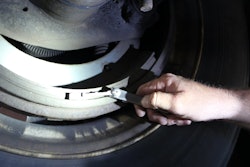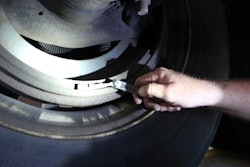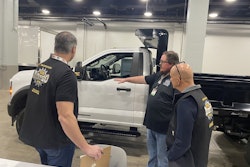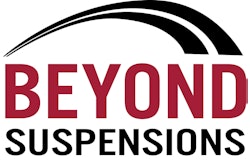By John Smith
In the 45 years he has been in the trucking industry, Dick Henning has seen some significant changes in steering systems – and he points to the evolution of their reservoirs as a prime example of what has occurred.
“They were metal and held a gallon or so of oil. Nowadays, they’re plastic and hold no more than a quart of oil,” recalls Henning, vice president of sales and marketing at BAB Steering and Hydraulics, which remanufactures steering components.
It is a change that makes the condition of the power steering fluid more important than ever, and it is why he says the condition of the protective filter is vital to any maintenance strategy.
“Most people don’t know there is a filter in the system. A lot of people don’t change it,” Henning says, and he admits to raising a few eyebrows with the suggestion that it should be replaced at the same interval as engine oil. Few customers will embrace that particular service interval, but he stresses that the condition of the filter should certainly be inspected at every opportunity.
In terms of the fluid that flows through the steering system, Henning says BAB Steering prefers the use of a manufacturer-recommended 15W40 oil rather than automatic transmission fluid or Dexron. “In 20-plus years of remanufacturing we find less internal wear and tear on gears using 15W40 than [on] gears using other fluids,” he says, stressing that the recommendations of individual manufacturers always should be followed.
But the steering specialist also stresses that every individual component needs to be considered in the context of the entire system.
“Everything on the front axle – the hub, drag link, tie rod, frame rail – it’s all attached, one part to the other,” Henning explains.
HOSE REPLACEMENT
Look at the hoses that deliver the fluid in the first place. Any inspection should check for hoses that are hard, brittle or loose on the barb that holds them in place. Hoses should certainly be replaced every five years regardless of their appearance because they can still be degrading internally, and installers should be careful to choose the right hose for the right application. For example, suction, pressure and return hoses have different internal diameters, which can have a dramatic impact on the proper sealing of the system.
“Every hose in the system is capable of ingesting air,” Henning explains, offering an example of the challenges that can emerge if installers use a pressure hose in place of a suction hose. In this case, the liner of the hose eventually will collapse and restrict the flow of the fluid.
The wrong hose clamps or a poor connection at the suction line also will allow air into the system. At some point that air will implode and remove the hard chrome surface from the input or sector shaft. It only takes 25 percent of the energy from the imploding bubble to remove the hard chrome surface. The remaining 75 percent of the energy is turned into heat.
It is a vicious cycle.
Further downstream, meanwhile, installers will need to ensure that a replaced steering gear is also correctly centered so the spool valve at the top of the gear is completely closed while the truck is heading straight down the road. If the steering wheel’s spokes are sitting at 4 and 8 o’clock, it is closed. Otherwise, fluid will continue to circulate instead of returning to the reservoir.
In addition to that, the timing marks on the sector shaft and pitman arm will need to be aligned properly so that all internal ports are closed.
“Circulating that small amount of fluid through the system is what causes the system to overheat,” Henning says.
PUMP, GEAR REPLACEMENT
As basic as it sounds, he also stresses the importance of matching the proper pump and gear with the truck on which it is installed. Every system requires a specific number of gallons per minute, so the pumps are not interchangeable.
“We typically live in a society that says, ‘If it bolts up, it must work,’” Henning says. “Steering gears, by design, usually only fit on one model of truck. What fits on a Kenworth T800 will not necessarily fit on a T600. Whatever fits on a cabover won’t fit on a conventional.”
Every Ross and Sheppard steering gear also has poppet valves that installers must adjust to account for any wear and tear in the system. Failure to do this can lead to problems such as an immediate leak.
They are all important steps to remember. Industry research suggests that 19 out of 21 steering system failures could be linked to improper installation procedures. It is a shocking statistic, particularly when you consider that 17 of the problem installations could be addressed without taking the unit off the truck.
Closer to the road, the maintenance program for steering axles also should pay close attention to the need for grease, says John Knutson, technical support manager for Hendrickson Truck Suspensions. No zerk fittings should be overlooked.
While suppliers can recommend re-greasing every 25,000 miles in an on-highway application, Knutson likes to see the grease gun applied within 12,000 to 15,000 miles. “Over the past 10 years or so, the stuff on the road in the winter has gotten much more caustic. It’s really gotten bad out there,” he explains, referring to de-icing compounds such as magnesium chloride.
Besides, he adds, grease is a cheap form of insurance.
The choice of the related grease will be dictated by the operating environment. A traditional NLGI 2 chassis grease may work in most cases, but it may not offer the required pumpability in the extreme cold.
Connected automatic greasing systems deserve some attention of their own. “With an automatic greaser, there is a tendency to forget about it,” Knutson says. The flow of the all-important lubricant could be affected by anything from a hole in the line to a plastic tie that is a little too tight.
Alignments also should be checked at least once a year, he adds. “Throughout the course of the year, a vehicle goes through a lot of events that can knock something out of whack.”
A shop that replaces a set of tires without checking the overall vehicle alignment may overlook the root cause of the problem, he says. “Typically, you’ve got eight tires pushing two and usually the eight tires are going to dictate what’s going on with the tires up front.”
In addition to checking the toe, thrust and scrub angles, however, he also stresses the importance of inspecting the U-bolts on the rear suspension. Otherwise, the angles could quickly change as soon as the truck drives out of the service bay and takes a tight turn.
In fact, the condition of fasteners should be checked across the steer axle at the first sign of trouble. Everything from king pin bushings to tie rod ends need to be tightened to a specific tolerance.
“U-bolts and hex bolts that connect the spring to the axle, those all fall under periodic re-torquing [procedures] and it’s critical that those fasteners are maintained,” Knutson says.
Before any alignment work is conducted, all ride heights also will need to be adjusted properly, he adds, referring to the growing popularity of air-ride components at the front of the vehicle.
When it comes to any steering maintenance, however, Knutson says the best diagnostic support can come from the driver.
“The first thing that should be done is identify what the customer complaint is. Then, prior to doing anything, we recommend you take the vehicle for a road test and verify the actual complaint,” he says. “Something could get lost in the translation when the customer is standing at the counter and talking to the service writer.”
It is the attention to detail that will ensure maintenance efforts go in the right direction.









